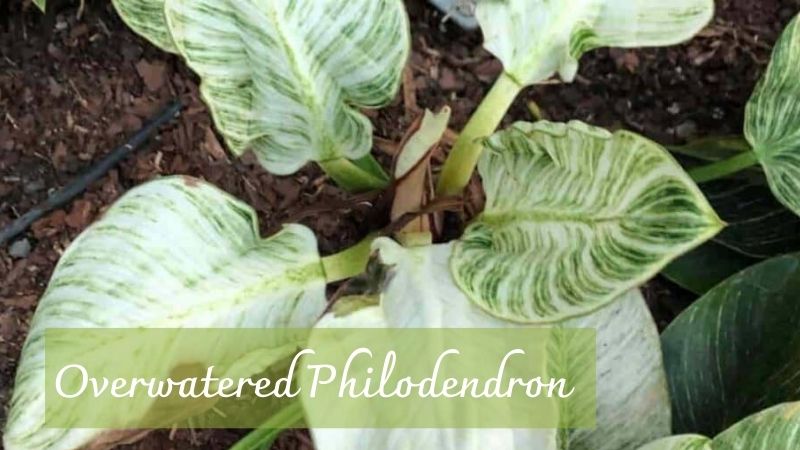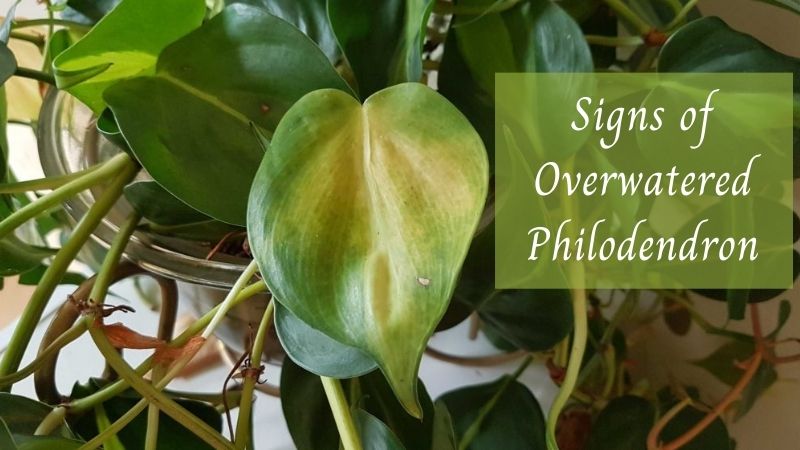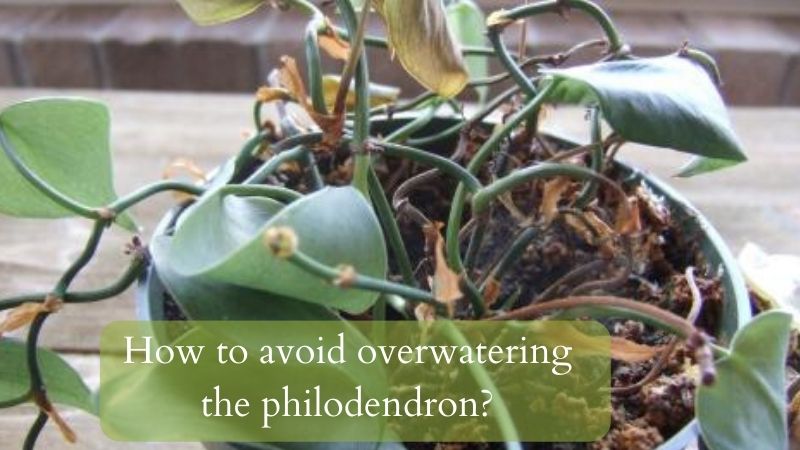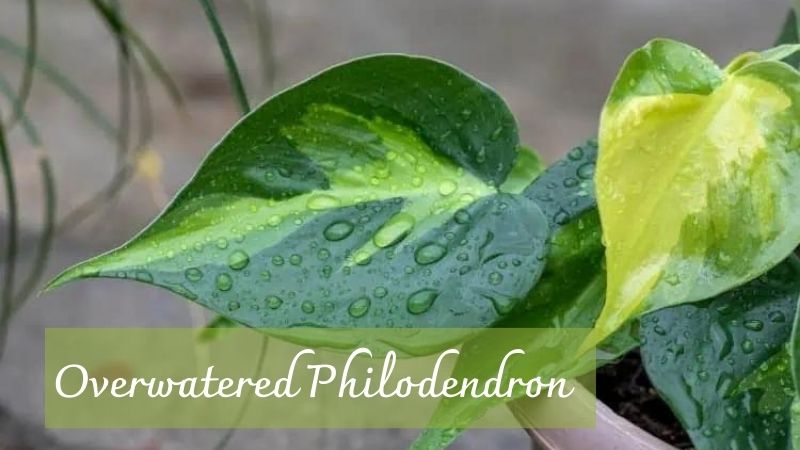Overwatering is a common problem that can turn your healthy Philodendron into a sickly plant. Figuring out the early signs, knowing the reasons, and taking effective recovery steps are super important in getting your overwatered Philodendron back to tip-top health. This all-in-one guide is your handbook in bringing back your plant’s vibrancy, helping you find your way through the tricky parts of plant care and making sure your Philodendron keeps thriving in your care.
What Is Overwatered philodendron?

The misunderstanding that often watering equals good growth is a usual mistake for many plant lovers. This belief can push your Philodendrons from thriving to struggling due to the dangerous condition known as overwatering, which leads to root decay.
Contrary to what people often think, Philodendrons, originally from tropical rainforests, don’t need non-stop watering. Instead, they love warm environments with a good soak now and then. So, understanding their natural homes can help in tweaking their watering schedules just right.
Another sneaky troublemaker of overwatering is the size and type of the pot you pick for your plant. The pot size should match the size of your plant. A too large pot with not enough drainage can create a soaked environment, leading to overwatering. On the flip side, a pot too small can choke the roots, resulting in a similar overwatered state.
Signs of overwatering, even when watering seems apparently okay, could point to problems with the pot, drainage system, or soil. So, it’s crucial to check these elements as potential causes of overwatering.
How to tell the difference between an underwatered and overwatered philodendron?
At first glance, overwatering and underwatering might show similar symptoms. However, what happens on the inside in both situations is different.
In an overwatered Philodendron, the soil gets super soaked, pushing out oxygen, a vital element for converting sugars to energy. This oxygen lack in the soil messes up the respiration process in the roots, reducing energy creation for the plant.
Underwatering, on the other hand, leads to drought-like conditions in the soil, causing non-living stress. The lack of water makes the roots work harder in seeking water, which overworks them and can eventually cause them to die.
Both situations mess up root health, messing up their efficiency in key jobs like water uptake and nutrient movement. As a result, signs of these watering issues often show up in the plant’s upper parts.
Figuring out whether your Philodendron is overwatered or underwatered can be tough, but certain signs can give hints. If the stem near the soil has turned mushy and brown, overwatering is likely the culprit. On the other hand, if the soil feels super dry and hard, underwatering may be the problem.
Signs of Overwatered Philodendron

Spotting signs of overwatering is a tricky job that needs careful observation. Depending on how bad the root system is damaged, different signs might pop up. Here are the key signs to help you diagnose overwatering in your Philodendron:
Root Rot
Root decay is probably the most distinct sign of overwatering. It’s hard to spot without actually looking at the plant’s roots, which means you’ll need to remove the plant from its pot. Overwatered, decaying roots usually show a dark brown to black color and a tender texture. They might appear slimy and easily break away from the plant’s base. Plus, they often give off a bad smell, showing how much damage there is.
Some roots may even show signs of germ invasion, a result of long-lasting exposure to super wet conditions. These germs can thrive when roots are weakened and damaged from a lot of time in water, causing more problems for your Philodendron.
As a tropical plant, Philodendrons naturally don’t like sitting in super wet soil. Overwatering for a long time messes up the roots’ job, making them take in too much water, which leads to them suffocating. These messed up roots slowly weaken, hurting the plant’s overall health and energy.
Brown Spots on Leaves
One of the clear signs of an overwatered Philodendron is the appearance of big brown spots on the leaf surfaces. These spots usually look like they’re soaked with water and might feel soft or squashy when touched.
At first, these spots may be small and in specific places, but if the overwatering continues, they can slowly get bigger and spread to other healthy leaves. You’ll most likely see these brown spots on the lower leaves of your Philodendron, although the leaf tips and edges can also start browning.
Along with the leaf surface, you might also see browning at the edges and tips of the leaves, which is another sign of overwatering. This widespread browning not only messes up the good looks of your Philodendron but also shows its messed up health.
Read more: Brown Spots On Philodendron Leaves: Causes – Solutions
Wilted and Mushy Appearance
Overwatering doesn’t just affect your Philodendron at the root level; it can cause visible damage to the entire plant. A key sign of this issue is a wilted, squishy look that shows severe stress.
When a Philodendron is overwatered, extra water floods the roots, messing up their function and leading to root decay. This harm then spreads throughout the plant, affecting its tissues and leaves. The result is a Philodendron with a soft and squishy look, its leaves turning from a vibrant green to a dull, lifeless brown. The plant might also look weak, unable to take up needed nutrients and moisture because of the messed up root system.
As the damage from overwatering gets worse, the whole plant begins to wilt. Most, if not all, of its leaves turn brown and squishy, signaling serious root harm and decay. If your Philodendron has reached this stage, its survival is at stake. So, spotting these signs early and acting fast is super important for saving your overwatered Philodendron from this bad situation.
Yellowing of Leaves
Another obvious symptom of an overwatered Philodendron is the leaves turning yellow. This color change often shows lack of nutrients, a direct result of a messed up root system because of overwatering.
Too much water can really drown the roots, messing up their key transport job. When this happens, the roots can’t efficiently pull up the necessary water and nutrients from the soil. This disruption in nutrient and water movement, in turn, affects the plant’s leaves.
The process often starts from the lower leaves and slowly spreads across the entire leaf surface, turning the once bright green leaves to a pale, unhealthy yellow. This yellowing shows that the Philodendron is starving for nutrients, a clear sign that the plant is suffering from overwatering.
Diseased Philodendron
Overwatering doesn’t just hurt your Philodendron on the inside; it can also leave it open to trouble. An overwatered Philodendron can easily become a target for various disease-causing illnesses, leading to its overall beat-up shape.
When roots are soaked for a long time, they become an easy target for bugs. These pathogens can thrive in the weak, water-soaked environment, leading to an array of health problems for your Philodendron. These diseases can cause even more trouble, adding to the damage from overwatering.
Infections can also spread from the roots to the plant’s stems and leaves, making your Philodendron even more sick. The easy-to-see damage often appears as spots, blemishes, and a dull, washed-out look on the plant’s leaves. This decline in plant health is a huge hint of overwatering.
Stem Rot at the Soil Line
Yet another troubling sign of an overwatered Philodendron is stem decay at the base. This ignored hint of overwatering is a straight-up result of the plant’s stems being in constant contact with the super soaked soil.
Stem decay shows itself on the part of the stem near the soil line, which is not only close to the roots but also vulnerable due to its closeness to the damp soil. As the decay gets worse, this part of the stem will become wobbly, droopy, and gooey to touch, a huge difference from the usual sturdy and strong nature of a healthy Philodendron stem.
An easy way to identify stem decay is during repotting. If the stem easily separates from the roots or snaps apart, it’s a clear hint of stem decay caused by overwatering.
Besides, the extra moisture from overwatering can also open the door for fungus problems, adding more to the damage to your Philodendron. Hence, spotting it early and coming up with fixes can sort out these issues and bring back the health of your loved plant.
Can plants recover from overwatering?
Yep, Philodendron plants can perk up after an overwatering incident, as long as their roots haven’t got really messed up. Even if overwatering has made the leaves wilt, your plant might still have the strength to bounce back.
Usually, plants that didn’t get enough water perk up quicker than their overwatered buddies. This speediness comes from the fact that underwatering mainly hits the leaves, while overwatering can cause a lot of damage to the roots, the lifeline of the plant.
With good care and the right fixes, most Philodendron plants may need anywhere between 7 to 14 days to get back on track. However, if your plant has taken big damage, it might need more time to recover.
So, while overwatering can be a big mistake, it’s not necessarily a death sentence for your Philodendron. With quick help and good care, your overwatered Philodendron can flourish once again.
How to fix an overwatered philodendron?

Saving an overwatered Philodendron depends on how bad it is, and you might need to mix up a few fixes. It’s all about trying things out, so don’t hesitate to try different methods until you see an improvement.
Cut down on the water
Right watering is super important to reverse the effects of overwatering. Start by cutting down on how often you water. Before watering again, make sure the soil is dry enough, try not to add more water if the soil feels damp or soggy.
Keep a close eye on your plant’s soil. If the soil is soaked, you might want to take away some of the mulch to speed up the drying. The goal is to let the soil dry out completely between waterings.
When it’s time to water again, do it carefully. Whether you’re using a watering can or putting your Philodendron under a tap, make sure to add water bit by bit until it starts to come out the bottom.
Put the Philodendron in a bright spot
To speed up the healing of an overwatered Philodendron, make sure the plant gets enough light, which helps the soil dry out. Put your Philodendron in a bright spot, but don’t forget to check the strength of the light. While Philodendrons like bright light, direct sunlight can be bad because they’re sensitive to strong light.
If there’s not much sun around, artificial light can be a good option. A mix of fluorescent and incandescent light can give the right mix for the plant’s needs. Also, try to put your plant somewhere with good air flow to help it dry.
To make sure it grows evenly, rotate your plant now and then, so all sides get light. You might also need to adjust your blinds or move your indoor lamps to get the best light.
With the right mix of light and less watering, your overwatered Philodendron can get healthy and strong again. However, be patient, as improvement may take time to show up.
Trim Off Dead and Damaged Leaves
Pruning is super important in helping an overwatered Philodendron recover. By trimming off damaged, decaying, or leaves that have changed color, you do more than just keep it looking good. This can also stop diseases spreading or bugs taking over the sick leaves. By getting rid of these messed-up leaves, you can help stop it getting worse with root rot, fungal infections, and bugs taking over.
Pruning damaged leaves also helps the overall health of the plant. By getting rid of sickly leaves, the Philodendron can focus on getting better and growing new leaves. This redirection of resources lets new leaves pop up and grow.
When doing this, remember to use clean tools to avoid spreading bugs. Always make clean cuts, which heal quicker and are less likely to let disease in. Given that Philodendrons have toxins, always wear gloves to protect your skin from getting irritated.
Repot the Philodendron
Repotting is one of the most crucial steps you can take to save an overwatered Philodendron. This process lets you check out the damage and gives you the chance to fix things, particularly with the roots and soil.
Start by carefully taking the plant out of its pot. Rinse off all the old soil and give the roots a good look. Cut away any dark or squishy roots using a clean, sharp tool. This helps stop root rot spreading and helps healthy roots grow.
When getting the Philodendron ready for its new home, remember to use light, well-draining soil, preferably with things like perlite, pine bark, or orchid mix. These help air get around the roots, which is super important for them to get better.
Choose the new pot wisely. Terracotta pots with enough holes to let water out or wire baskets with coco coir liners are good choices. They let excess water drain easily and stop water sitting around, which is key in stopping overwatering in the future.
Once your Philodendron is repotted, change your watering schedule to make sure the plant gets the right amount of moisture. A good watering routine combined with the right soil and pot can breathe new life into your overwatered Philodendron.
Use Fungicide on a Diseased Philodendron
Using a fungicide can be key in bringing an overwatered, diseased Philodendron back to health. These are designed to stop, kill, or prevent fungal diseases, making them a good way to fight conditions often linked to overwatering.
Starting on the fungicide journey, you’ll need to carefully take your plant out of its pot and clean the roots with running water. Keep a close eye and check how they look. If the roots look dark and squishy, it’s a sure sign of infection and you need to cut them off using clean, sharp tools. This act of pruning does two things – it gets rid of the worst parts and helps good roots grow.
Next, it’s important to figure out the exact kind of fungus causing the infection. Different fungi need different things, so knowing what you’re dealing with is half the battle. Once you’ve worked out what fungus it is, pick the right fungus killer and put the roots in the stuff as directed. This will help get rid of any left-over fungus.
After the fungicide treatment, make sure to wash the plant properly to get rid of extra fungus killer that might stop the plant growing or cause other problems. Then, repot your Philodendron in a new pot with fresh, clean soil. This gets rid of any bugs from the old soil and gives your plant a clean, good place to get better.
Lower Humidity
Even though Philodendrons are tropical plants that do well in places with lots of humidity, an overwatered plant might need a bit of a break from all that moisture. Lots of humidity makes the plant keep more moisture, basically stretching out how long it stays waterlogged.
One fix for this is to move your Philodendron to a place with drier air. This can speed up the water release process, helping the plant to get rid of extra moisture more efficiently. Plus, if you’re in the habit of regularly misting your plant, think about taking a break from this for now until the Philodendron shows signs of getting better.
To lower high humidity levels for an overwatered Philodendron, making the air move more and dropping the temperature around it can be helpful. These actions contribute to drying out the soil, helping to stop root rot from happening. It’s a good idea to place the plant in a warm place with good air movement, which encourages water to evaporate and stops water from piling up. Putting these strategies to work can create a helpful environment for your water-soaked Philodendron to recover.
How to avoid watering the philodendron too much?

Stopping overwatering of your Philodendron involves understanding how much water it needs and keeping an eye on the soil and surrounding conditions. Here are some tips to help avoid watering too much:
- Only water your Philodendron when the top inch of the soil is dry.
- The pot should have a good drainage system to stop it from becoming waterlogged.
- Use a soil mix that drains well to stop water from just sitting still around the roots.
- Change how often you water according to the season. You’ll need more water during the warm growing periods, and less during the winter.
- Change your watering habits based on where the plant is. A Philodendron in a bright area will likely need more water than one in a low-light area.
- Try watering the plant from the bottom by putting the pot in a tray of water for a few hours. But don’t let the pot stay soaked all night.
Conclusion
Managing an overwatered philodendron can initially appear overwhelming, but with careful implementation of strategic care methods, it becomes achievable. This includes providing the correct lighting, implementing timely pruning, opting for suitable repotting, and controlling humidity levels. As you follow these guidelines, your plant’s revival journey becomes much smoother. For further assistance and a wealth of comprehensive plant care guides and tips, continue exploring Famiplants – your trusted companion in the wonderful world of horticulture.

